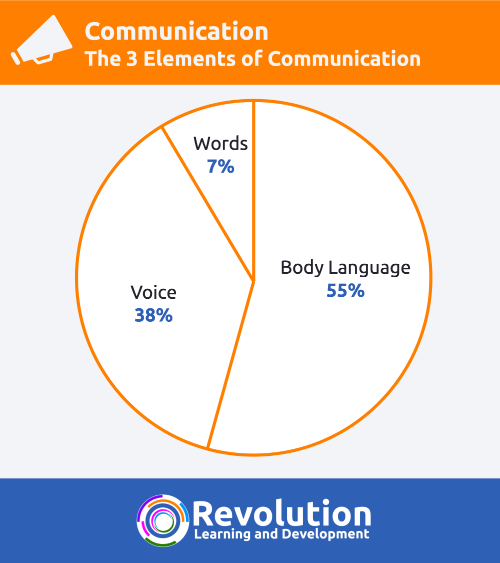Background
The 3 Elements of Communication – Body Language, Voice and Words. When we communicate with someone face to face we pass the information and understanding through 3 different elements – body language, voice and words. The message isn’t however communicated equally across all 3. This was demonstrated in a theory by Dr. Albert Mehrabian in 1970.
Body Language, Voice and Words
In his work, Albert Mehrabian suggested the percentage split between body language, voice and words were:

- Body Language – the visible actions that we show to others using all parts of our body – 55%
- Voice – the pitch, pace, tone and volume of our voice – 38%
- Words – the actual words that make up our message – 7%
This often surprises many people as they often think the words make up most of the communication. In reality, it’s the visible things we show that communicates most of the message as this is where most people’s perceptions are formed – from what they can see.
Albert Mehrabian suggested that, even with the absence of tone of voice and words, the body language we demonstrate will still communicate a message to others.
Albert Mehrabian suggested that, even with the absence of tone of voice and words, the body language we demonstrate will still communicate a message to others. Share on X
Using the 3 Elements Together
When we communicate on a face to face basis, we use all 3 of these elements. If we want to communicate effectively, we need to give thought to all 3. We need to make sure that each element is matched with each other and the message to ensure our message is received and understood. For example:
You want to deliver a positive upbeat message. You have all of the right words in your communication. It’s packed full of positive statements. But, your tone is monotone and your body language negative. It is much more likely that your message will not be received positively.
You need people to believe in your message and take action. You have the right words and you deliver the message in a confident tone. But, you are fidgeting. You look nervous and don’t make eye contact. It is likely that people won’t see you as confident; therefore, they won’t have confidence in your message.
You are delivering a difficult message. Maybe it’s bad news. You have the right body language and tone but you are trying to put too much of a positive spin on things by using too much positive language. The recipients may become confused.

As you can see, when all 3 communication elements don’t work together, we can’t communicate effectively.
Communicating Via Different Channels
While the above works for face to face communication, what about other communication channels such as the telephone and email? We might assume that they just get forgotten about because they are no longer relevant. This isn’t true. We might think the percentages adjust to take the new communication channel into account. This is partly true.
Communicating on the Telephone
Here the assumption is that we lose body language. In some cases, it is thought that the percentage split changes to 70% voice and 30% words. This is probably true, but have you ever considered how your body language can affect your tone of voice while you are talking on the phone? If you are slouched in your chair, this position can affect how you think and feel. We feel relaxed and comfortable. This will begin to change our tone and, because the person you are communicating with can’t see you, they might perceive this as a lack of interest or that you just don’t care.
Body language still plays an important part in communicating on the phone, especially when communicating with clients or customers. Behave as if the customer was there with you and this will ensure your body language doesn’t affect your tone.
Instead of thinking the split becomes 70/30, think as if you are losing 55% per cent of your ability to communicate effectively.
Body language still plays an important part of communicating on the phone, especially when communicating with clients or customers. Behave as if the customer was there with you and this will ensure your body language doesn't affect… Share on X
Communicating Via Email
The assumption with email is that it is 100% words and this assumption is correct. The difficulty is that words can be easily misinterpreted or misunderstood. This is why we should take careful care about the words we use, prepare our written communication carefully, put ourselves in the recipient’s shoes then write what we want to say. Then we should read it again and check it for ambiguity and places where the message could be misunderstood.
Instead of thinking written communication is 100% words, think as if you are losing 93% of your ability to communicate effectively.
Further Learning
If you would like to learn more about using body language, voice and words to communicate more effectively then a communication Skills training course can help. Take a look at our Communication Skills Training Course for details.




